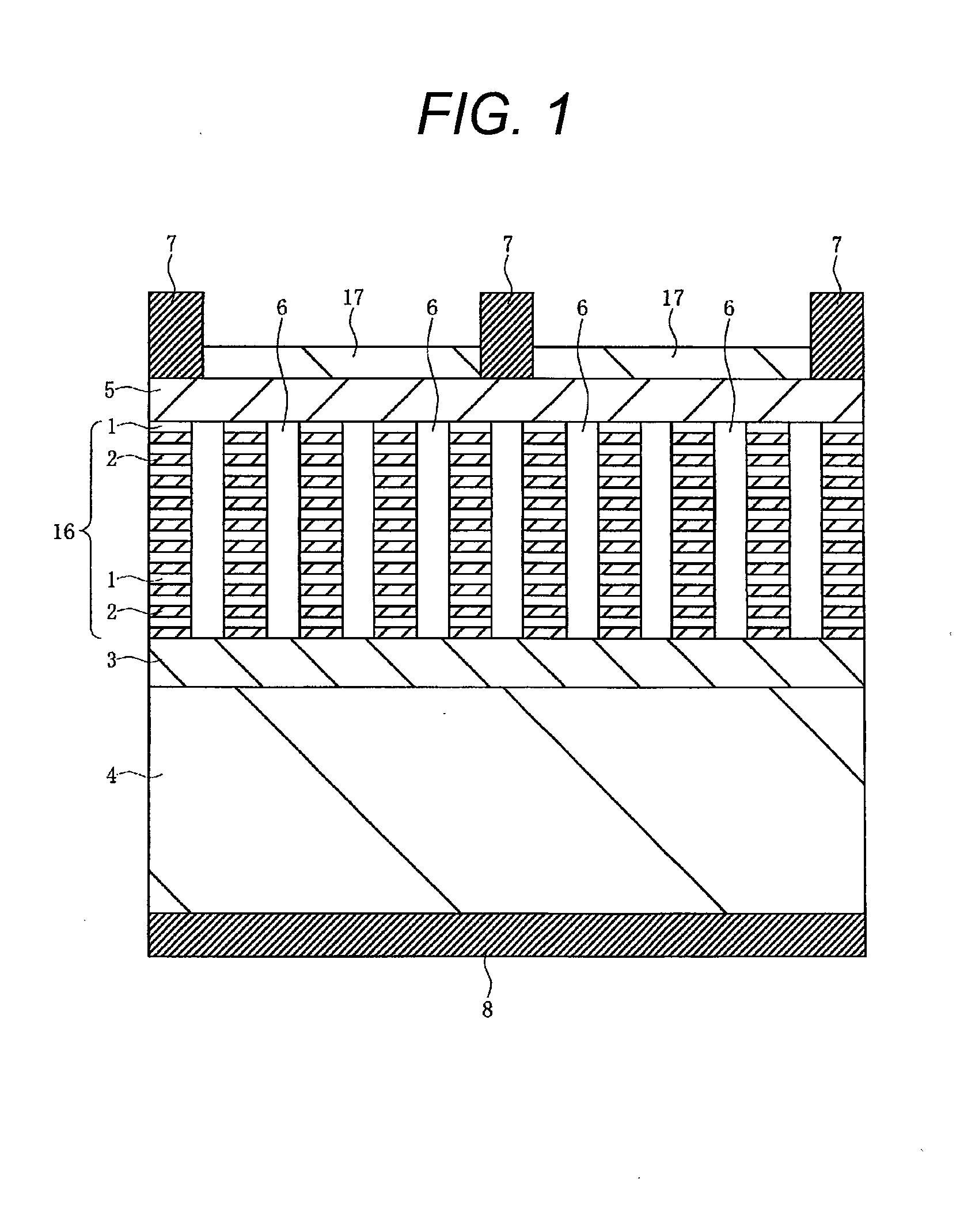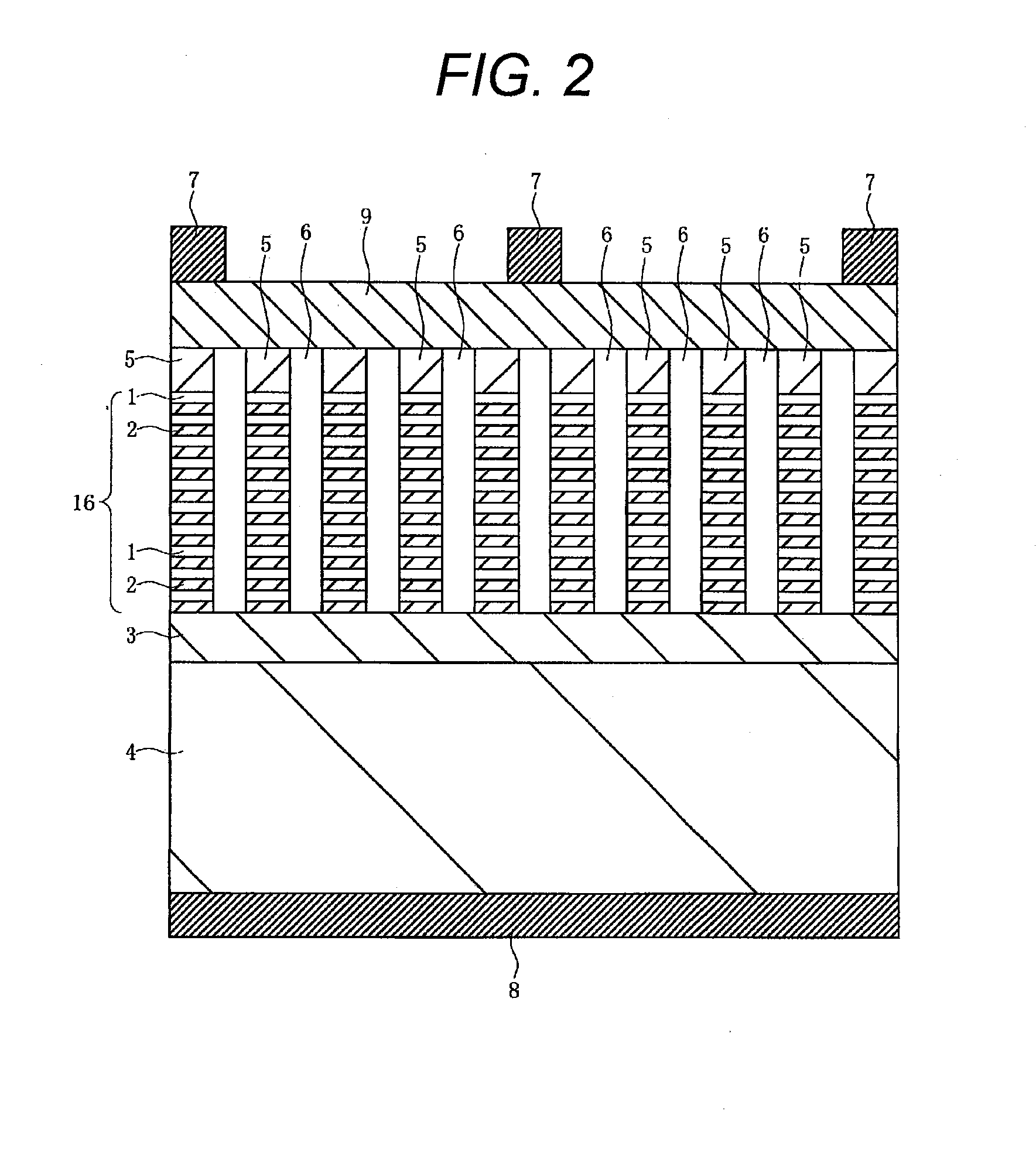Solar cell
- Summary
- Abstract
- Description
- Claims
- Application Information
AI Technical Summary
Benefits of technology
Problems solved by technology
Method used
Image
Examples
example 1
[0064]A solar cell according to Example 1 of the present invention is described with reference to a cross-sectional view of relevant parts of a solar cell illustrated in FIG. 1.
[0065]The feature of the structure of the solar cell according to Example 1 is to include a nanopillar array including a plurality of nanopillars (hereinafter, referred to as Si / SiGe nanopillars) constituted with a Si / SiGe superlattice including Si layers 1 and SiGe layers 2 laminated in an alternate manner arranged in a two-dimensional array on a primary surface of a p-type semiconductor substrate 4.
[0066]For example, a p-type semiconductor layer 3 is formed on the primary surface (front surface, first surface) of the p-type semiconductor substrate 4 formed of a Si single crystal. An impurity concentration of the p-type semiconductor layer 3 is higher than that of the semiconductor substrate 4, which is, for example, about 1018 cm−3 to 1020 cm−3. The p-type semiconductor layer 3 can be formed by an impurity ...
example 2
[0081]In the above-mentioned solar cell according to Example 1, the n-type semiconductor layer 5 is formed on the entire surface of the nanopillar array area 16 (nanopillar array and the inter-layer insulation film 6). In contrast to this, in a solar cell according to Example 2 of the present invention, an n-type semiconductor layer 5 is formed only on upper surfaces of the plurality of Si / SiGe nanopillars, and the n-type semiconductor layer 5 and a front surface electrode 7 are electrically connected to each other via a transparent conductive film 9 formed on the n-type semiconductor layer 5. The solar cell according to Example 2, which is configured in this manner, is described with reference to a cross-sectional view of relevant parts of the solar cell illustrated in FIG. 2.
[0082]In the similar manner to the above-mentioned example 1, for example, a p-type semiconductor layer 3 is formed on the primary surface of a p-type semiconductor substrate 4 formed of a Si single crystal.
[0...
example 3
[0093]In Example 3 of the present invention, a modification example of the solar cell according to the above-mentioned example 1 is described. In the solar cell according to the above-mentioned example 1, the p-type semiconductor layer 3 is formed on the p-type semiconductor substrate 4. In contrast to this, in a solar cell according to Example 3, an n-layer semiconductor layer 18 having an impurity concentration higher than that of the p-type semiconductor substrate 4 and a tunnel junction layer 13 including an p-layer semiconductor layer 11 and a p-type semiconductor layer 12 are formed between a p-type semiconductor substrate 4 and a p-type semiconductor layer 3. The solar cell according to Example 3 configured in this manner is described with reference to a cross-sectional view of relevant parts of the solar cell illustrated in FIG. 3.
[0094]For example, the n-type semiconductor layer 18 having an impurity concentration higher than that of the p-type semiconductor substrate 4 is ...
PUM
 Login to View More
Login to View More Abstract
Description
Claims
Application Information
 Login to View More
Login to View More - R&D
- Intellectual Property
- Life Sciences
- Materials
- Tech Scout
- Unparalleled Data Quality
- Higher Quality Content
- 60% Fewer Hallucinations
Browse by: Latest US Patents, China's latest patents, Technical Efficacy Thesaurus, Application Domain, Technology Topic, Popular Technical Reports.
© 2025 PatSnap. All rights reserved.Legal|Privacy policy|Modern Slavery Act Transparency Statement|Sitemap|About US| Contact US: help@patsnap.com



